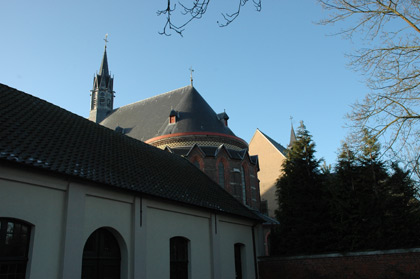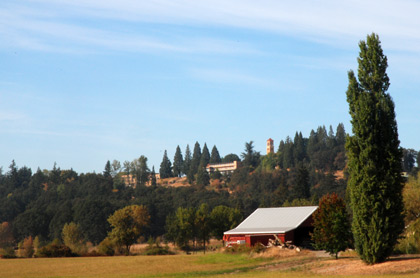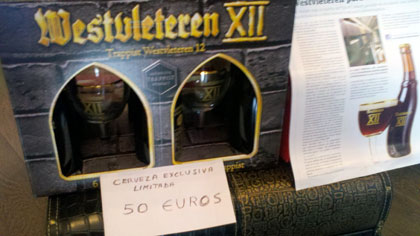The topic for the 82nd gathering of The Session today is “Beery yarns.” Host Steve Lamond suggests that both beery tall tales and gentle recollections are appropriate. I’ve chosen the latter, and what follows is taken almost directly from “Brew Like a Monk” — and written, yikes, going on nine years ago.

Inside the brewery café at the monastery of the Saint Benedictus Abbey of Achel, only a single food server and one monk putting items on his cafeteria tray remained when Marc Beirens opened the door and stepped into a chilly December evening.
Beirens, a businessman who has been visiting monasteries since he was a child, took a few strides into a terrace area that was once the abbey’s courtyard. As the sky above turned from dark blue to black, he nodded back toward the brewery, located in a space that once housed the monastery dairy, then to a new gallery and gift shop to his right. Those buildings held pigs and more cattle, before it became obvious agriculture would not sustain the community.
“You should have seen this all a few years ago,” he said, his voice bouncing lightly about an otherwise silent courtyard.
 Beirens appreciates the importance of commerce to the monasteries, and that the six Trappist breweries are part of a larger family. He distributes a range of monastic products — beer is the best selling, but they include cookies, soap, vegetables, wine, and other goods — throughout Belgium and France. His father did the same. “I’ve been visiting monasteries since I was this high,” he said earlier, holding his hand below his waist. That’s why he understands something else about monasteries.
Beirens appreciates the importance of commerce to the monasteries, and that the six Trappist breweries are part of a larger family. He distributes a range of monastic products — beer is the best selling, but they include cookies, soap, vegetables, wine, and other goods — throughout Belgium and France. His father did the same. “I’ve been visiting monasteries since I was this high,” he said earlier, holding his hand below his waist. That’s why he understands something else about monasteries.
It was dark now, and the courtyard empty.
“I love the silence,” Beirens said. “I used to have a friend who was a monk. He’s gone now.”
We walked along in silence.
“When he was 80 or so, I’d still call him. If I had a problem I could go see him. He didn’t have to say anything and I’d feel better.
“All it took was silence.”
*****
Achel’s is the smallest of the six Trappist breweries in Belgium, yet I can buy its beers a 20-minute walk from my home in Clayton, Missouri. Unfortunately those don’t include the two lower alcohol beers, one pale and one dark, sold only on draft at the pub. The 5° Blond is a particular delight, showcasing subtle fruity aromas and flavors, spicy and properly bitter. It is a reminder how satisfying a relatively “simple” beer can be.

